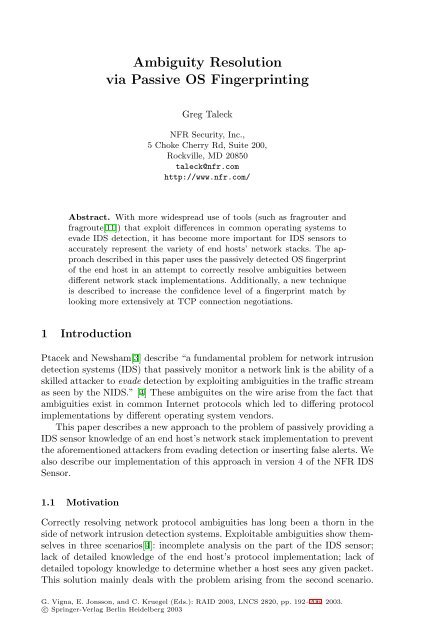LNCS 2820 - Ambiguity Resolution via Passive OS Fingerprinting
LNCS 2820 - Ambiguity Resolution via Passive OS Fingerprinting
LNCS 2820 - Ambiguity Resolution via Passive OS Fingerprinting
Create successful ePaper yourself
Turn your PDF publications into a flip-book with our unique Google optimized e-Paper software.
<strong>Ambiguity</strong> <strong>Resolution</strong><br />
<strong>via</strong> <strong>Passive</strong> <strong>OS</strong> <strong>Fingerprinting</strong><br />
Greg Taleck<br />
NFR Security, Inc.,<br />
5 Choke Cherry Rd, Suite 200,<br />
Rockville, MD 20850<br />
taleck@nfr.com<br />
http://www.nfr.com/<br />
Abstract. With more widespread use of tools (such as fragrouter and<br />
fragroute[11]) that exploit differences in common operating systems to<br />
evade IDS detection, it has become more important for IDS sensors to<br />
accurately represent the variety of end hosts’ network stacks. The approach<br />
described in this paper uses the passively detected <strong>OS</strong> fingerprint<br />
of the end host in an attempt to correctly resolve ambiguities between<br />
different network stack implementations. Additionally, a new technique<br />
is described to increase the confidence level of a fingerprint match by<br />
looking more extensively at TCP connection negotiations.<br />
1 Introduction<br />
Ptacek and Newsham[3] describe “a fundamental problem for network intrusion<br />
detection systems (IDS) that passively monitor a network link is the ability of a<br />
skilled attacker to evade detection by exploiting ambiguities in the traffic stream<br />
as seen by the NIDS.” [4] These ambiguites on the wire arise from the fact that<br />
ambiguities exist in common Internet protocols which led to differing protocol<br />
implementations by different operating system vendors.<br />
This paper describes a new approach to the problem of passively providing a<br />
IDS sensor knowledge of an end host’s network stack implementation to prevent<br />
the aforementioned attackers from evading detection or inserting false alerts. We<br />
also describe our implementation of this approach in version 4 of the NFR IDS<br />
Sensor.<br />
1.1 Motivation<br />
Correctly resolving network protocol ambiguities has long been a thorn in the<br />
side of network intrusion detection systems. Exploitable ambiguities show themselves<br />
in three scenarios[4]: incomplete analysis on the part of the IDS sensor;<br />
lack of detailed knowledge of the end host’s protocol implementation; lack of<br />
detailed topology knowledge to determine whether a host sees any given packet.<br />
This solution mainly deals with the problem arising from the second scenario.<br />
G. Vigna, E. Jonsson, and C. Kruegel (Eds.): RAID 2003, <strong>LNCS</strong> <strong>2820</strong>, pp. 192–206, 2003.<br />
c○ Springer-Verlag Berlin Heidelberg 2003
<strong>Ambiguity</strong> <strong>Resolution</strong> <strong>via</strong> <strong>Passive</strong> <strong>OS</strong> <strong>Fingerprinting</strong> 193<br />
That is, how can the IDS gain more detailed information about the end host in<br />
a passive environment?<br />
The ambiguity of the Internet Protocol[16] with respect to fragmentation<br />
leads to numerous problems. The most serious of these is to accurately determine<br />
exactly what a given end host would see in the presence of overlapping<br />
fragments, to properly detect network intrusions, when, and only when they<br />
actually happen.<br />
Implementations of the Transmission Control Protocol[17] also vary with<br />
respect to handling TCP segments with overlapping TCP data. The specfication<br />
states that segments should be trimmed to only contain new data, but in practice,<br />
network stacks handle this condition in different ways.<br />
These two problems present two common exploitable conditions for current<br />
IDS sensors. We attempt to minimize these opportunities for attackers with the<br />
approach described in this paper.<br />
The rest of the paper is organized as follows: Section 2 looks at related<br />
work and research in this area. Section 3 looks at existing, state-of-the-art fingerprinting<br />
technology. In Section 4, we describe how we build the fingerprint<br />
databases and show new techniques for accurately identifying host operating<br />
systems. Section 5 shows our current implementation and 6 expands on the resource<br />
consumption of our implementation, including methods to reduce it. Our<br />
results and measurements are presented in Section 7 and other areas of possible<br />
research and future work are described in Section 8.<br />
2 Related Work<br />
2.1 Active Mapping<br />
Inspiration for this work is drawn mainly from the research done on Active<br />
Mapping[1]. This method relies on a separate system, the Mapper, to actively<br />
map hosts within a network to determine its ambiguity resolution policies. That<br />
is, how does a host interpret ambiguous packets. The Mapper builds a Host<br />
Profile Table by sending different combinations of overlapping, fragmented IP<br />
packets and overlapping TCP segments. It then feeds that host profile information,<br />
or ambiguity resolution policies, to an IDS sensor. When the IDS detects an<br />
ambiguity on the wire, it looks up the IP in the Host Profile Table for instruction<br />
on how to resolve it.<br />
Unfortunately, there are drawbacks to this type of setup for many network<br />
installations. By definition, Active Mapping requires that the mapper actively<br />
send out anomalous traffic that may be rejected by firewalls or routers within the<br />
network. Clients that are dynamically assigned IP addresses <strong>via</strong> DHCP would<br />
fail to be mapped properly, and could potentially be mapped to a different profile<br />
of another machine. These handcrafted packets could also potentially harm hosts<br />
on a network.
194 G. Taleck<br />
2.2 Traffic Normalization<br />
Traffic normalization[5] solves the problem of ambiguity by mostly (or completely)<br />
eliminating it. A traffic normalizer acts as a gateway for all ingress,<br />
and possibly egress, traffic and removes any ambiguities when it detects them.<br />
However, traffic normalization cannot always scale to large networks because of<br />
the process overhead per packet, and can also break connectivity between hosts<br />
when they rely on un-normalized traffic. Normalizers must also be extremely<br />
fault tolerant, as any traffic that is to enter the network must first pass the<br />
normalizer.<br />
2.3 nmap, queso, ettercap, p0f, prelude-ids<br />
Active and passive <strong>OS</strong> fingerprinting tools have been around for quite some time.<br />
These tools identify hosts by taking advantage of subtle variations in network<br />
stack implementations. Mainly ICMP and TCP packets are used to remotely<br />
deduce operating system type. Fyodor’s nmap[7] tool, first released in 1997,<br />
makes extensive use of variations in reply packets from hosts when sent invalid,<br />
unusual, or non-conforming payloads, as does queso[12]. The p0f [13] tool uses<br />
the unique variations of TCP SYN Segments to passively identify hosts on a<br />
network. Similarly, ettercap [14], a multi-purpose network sniffer, attempts to<br />
identify hosts in the same fashion as p0f. Recently, a patch was submitted to<br />
the Prelude IDS Development [15] (prelude-devel) mailing list that can extract<br />
pertinent fingerprint information from a TCP SYN or SYNACK segment and<br />
save it to a database in the ettercap signature style. This allows Prelude-IDS<br />
users the ability to attempt to identify either an attacker’s or victim’s host<br />
operating system.<br />
These tools implement valuable approaches to identifying hosts on a network<br />
that have not yet been widely integrated into available IDS solutions. However,<br />
the information they provide can only be used to forensically investigate an<br />
attack. In other words, these approaches collect data from TCP SYN/SYNACK<br />
segments that can then be used later to assess the host.<br />
3 <strong>OS</strong> <strong>Fingerprinting</strong><br />
Two methods exist for remotely fingerprinting hosts on a network: active and<br />
passive.<br />
3.1 Active <strong>Fingerprinting</strong><br />
Active fingerprinting requires one to send interesting, malformed, and unique<br />
payloads to a remote host and examine the values returned by the host. Both<br />
the nmap and queso tools do this. The common tests send special combinations<br />
of TCP flags, such as FIN—PSH—URG, with a NULL TCP payload to both<br />
open and closed ports on the host.
<strong>Ambiguity</strong> <strong>Resolution</strong> <strong>via</strong> <strong>Passive</strong> <strong>OS</strong> <strong>Fingerprinting</strong> 195<br />
3.2 <strong>Passive</strong> <strong>Fingerprinting</strong><br />
<strong>Passive</strong> fingerprinting attempts to determine the host type by passively monitoring<br />
a network link, and not sending any traffic onto the wire. Existing passive<br />
<strong>OS</strong> fingerprinting tools examine the values of fields in the IP and TCP headers<br />
of initial TCP SYN segments sent from clients. Common fields used are:<br />
– Initial Window Size (WS)<br />
– Time To Live (TTL)<br />
– Maximum Segment Size (MSS)<br />
– Don’t Fragment (DF) Bit<br />
– Window Scale Value<br />
– SackOK option presence<br />
– Nop option presence<br />
This technique also relies on requiring an exact match of all the fields used<br />
in the fingerprint 1 .<br />
Other techniques[20] look at how to detect network stack implementations<br />
by examining TCP segments throughout the connection, or by examining the<br />
timing of TCP segments traveling back and forth[24].<br />
3.3 Defeating <strong>OS</strong> <strong>Fingerprinting</strong><br />
As accurate as both active and passive <strong>OS</strong> fingerprinting may be, there are methods<br />
to prevent a potential attacker from guessing a host’s operating system[9].<br />
For example, a host can fool p0f, in the simplest case, by changing any one of<br />
the values enumerated above. Fooling nmap or queso requires a little more effort,<br />
since these tools send multiple tests. In order to avoid detection, one must ensure<br />
that a majority of the tests sent fail to provide enough intelligence to make a<br />
guess.<br />
3.4 Exploitation of the TCP Three-Way Handshake<br />
Existing passive fingerprinting tools work by looking at the first SYN segment of<br />
a TCP connection. However, the replying SYNACK from the server can also yield<br />
pertinent information that can be used to identify the host. Since the servers are<br />
typically within the same network as the deployed IDS, this information is much<br />
more important. Most attacks are initiated by the client side of the connection.<br />
Additionally, if a person or program were to try to evade an IDS, they would<br />
do so in order to push an attack through without the IDS detecting it. Since<br />
the server side that will be accepting the ambiguous traffic, it is this side we are<br />
more interested in fingerprinting.<br />
During the three-way handshake to initialize the TCP connection, a client<br />
connects to a server within the network by sending a TCP SYN segment, and<br />
1 Exceptions to this are the p0f tool, which will incrementally alter the TTL field to<br />
obtain a match since a packet in flight can have a variable TTL value depending on<br />
the network path taken, and Xprobe, which can use a best-match algorithm.
196 G. Taleck<br />
IDS<br />
Client<br />
Server<br />
SYN<br />
SYNACK<br />
fragment 1 (24 bytes at offset 0)<br />
AAAABBBBCCCC_attack_code<br />
fragment 2 (20 bytes at offset 12)<br />
DDDDEEEEFFFFGGGGHHHH<br />
?<br />
2 possible resolutions of ambiguity by the IDS:<br />
AAAABBBBCCCCDDDDEEEEFFFFGGGGHHHH<br />
(Last Policy)<br />
AAAABBBBCCCC_attack_codeGGGGHHHH<br />
(First Policy)<br />
Fig. 1. Network packets from a potential attacker and its victim as seen by an IDS.<br />
the server replies with a SYNACK segment. Consider the example shown in<br />
Figure 1, where packets are sent between a client (potential attacker) and server<br />
(potential victim) as seen by an IDS sensor.<br />
In this scenario, the only information seen on the wire that can be used to<br />
identify the server is the SYN from the client and the corresponding SYNACK<br />
reply from the server to open the connection. However, depending on the values<br />
within the TCP header and the options present within the SYN from the attacker<br />
and how the server negotiates those options, it is possible to make a guess at the<br />
operating system of both the client and the server. If an accurate guess is made<br />
for the operating system type of the server, then we can attempt to resolve the<br />
ambiguity in the subsequent fragmented packets sent by the client to the server<br />
and have a better chance of determining whether an attack occurred.<br />
Another example can be an attack from a server to a client, where we can<br />
lookup the client <strong>via</strong> its TCP SYN segment and possibly determine the operating<br />
system type. Consider the case where a web browser within the network connects<br />
to a malicious server outside of the network in an attempt to gain control of the<br />
client.
<strong>Ambiguity</strong> <strong>Resolution</strong> <strong>via</strong> <strong>Passive</strong> <strong>OS</strong> <strong>Fingerprinting</strong> 197<br />
It should be noted the the ettercap tool mentioned in Section 2 does have an<br />
entry for the ACK bit in its signature database. However, it does not correlate<br />
the formation of the SYNACK response to the SYN request.<br />
The next section describes how we can build a collection of fingerprints and<br />
their corresponding ambiguity resolution policies.<br />
4 Building TCP SYN/SYNACK Fingerprint Tables<br />
In order to passively map hosts on a network to a particular operating system,<br />
we need to deploy IDS sensors with a pre-built table containing mappings of<br />
TCP SYN/SYNACK fingerprints to ambiguity resolution policies. Two tables<br />
are necessary: one table for identifying TCP SYN segments and another, more<br />
important, table for identifying TCP SYNACK segments. We use the existing<br />
active fingerprinting techniques, as well as some new ones, to build these policy<br />
tables.<br />
4.1 Eliciting TCP SYNs<br />
The p0f tool contains a reasonably robust table of fingerprints to map TCP SYN<br />
segments, but it requires human intervention to keep it up-to-date. To automate<br />
this task, one simply needs to be able to automatically elicit TCP SYN segments<br />
from a variety of hosts, keep track of the values set in the SYN segment, and<br />
then use an active <strong>OS</strong> fingerprinting tool, such as nmap, to identify the operating<br />
system. We do this with a tool that scans the Internet at large for hosts running<br />
FTP servers that accept anonymous connections 2 . Luckily, there are many of<br />
these. The tool connects to the FTP server, attempts to negotiate and verify<br />
active transfer mode (since most FTP servers default to passive), and invokes<br />
the LIST command to obtain a directory file listing. This results in a TCP SYN<br />
segment sent from the FTP server to the listening port sent by the FTP client,<br />
as shown in Figure 2.<br />
The tool uses libpcap[23] to catch all initial SYN segments with a TCP<br />
destination port equal to the port number sent in the FTP LIST command,<br />
and gathers the fields and values present in the SYN segment. It then detects its<br />
fragment reassembly policy and overlapping TCP segment policy using the same<br />
methods described in [1]. This is done by sending specially crafted IP fragments<br />
and TCP segments across the same TCP connection and observing how the host<br />
responds. The tool then attempts to identify the host <strong>OS</strong> type by forking off<br />
an nmap process. If nmap fails to identify the host operating system, we will still<br />
know how that stack resolves network protocol ambiguities. Having knowledge of<br />
the host operating system is really only useful as eye candy to an administrator.<br />
2 It is also possible to exploit the gnutella protocol by creating a lightweight client to<br />
connect to the network and both accept connections and send PUSH descriptors to<br />
elicit TCP SYN segments. This would nicely complement the set of SYNs from FTP<br />
servers, which are primarily high-end <strong>OS</strong>’s.
198 G. Taleck<br />
Minimal FTP Client<br />
FTP Server<br />
TCP Connect<br />
USER anonymous<br />
PASS pass@word.org<br />
PORT ip,ip,ip,ip,port,port<br />
LIST<br />
FTP Banner sent<br />
Anonymous access ok<br />
Login successful<br />
PORT command successful<br />
LIST data sent to port PORT<br />
Look for TCP SYN Segment with<br />
destination port PORT<br />
QUIT<br />
Connection closed<br />
Fig. 2. Sample network dialogue between a minimal FTP client and an FTP server to<br />
elicit a TCP SYN segment from the server.<br />
By polling many hosts, we can also weed out bogus entries where administrators<br />
have set up the host to fool nmap by using methods described in Section<br />
3.3. Since this tool really requires no human interaction, it can continuously poll<br />
new IP’s and re-poll old ones.<br />
4.2 Eliciting TCP SYNACKs<br />
The process of eliciting TCP SYNACK segments from a host is much simpler.<br />
This only requires that the host have at least one unfiltered port open. Existing<br />
active <strong>OS</strong> fingerprinting tools, such as nmap and queso, utilize a number of TCP<br />
tests against open ports to evaluate the network stack behavior. We also utilize<br />
these tests, and additionally, make more extensive use of TCP options.<br />
The most prevalent TCP options used in common, modern operating systems<br />
are the Maximum Segment Size (mss), Selective Acknowledgment (sackok),<br />
Timestamping (timestamp), and the Window Scaling (wscale) options. nmap<br />
first exploited the use of these options as the default set to actively examine<br />
stack implementations in nmap. Fyodor mentions that TCP options are “truly a<br />
gold mine in terms of leaking information”[7]. However, nmap fails to fully mine<br />
the information available <strong>via</strong> these options.<br />
TCP Options Tests. Using these four most common TCP options, 16 new<br />
nmap-like tests are created. Once a host is found with at least one open port, 16
<strong>Ambiguity</strong> <strong>Resolution</strong> <strong>via</strong> <strong>Passive</strong> <strong>OS</strong> <strong>Fingerprinting</strong> 199<br />
Table 1. Enumeration of the possible combinations of TCP options, padded appropriately<br />
with nop options .<br />
# Possible combinations of TCP options<br />
1 mss 1460<br />
2 timestamp nop nop<br />
3 sackok nop nop<br />
4 wscale 0 nop<br />
5 wscale 0 nop sackok nop nop<br />
6 wscale 0 nop mss 1460<br />
7 wscale 0 nop timestamp nop nop<br />
8 sackok nop nop mss 1460<br />
9 sackok nop nop timestamp nop nop<br />
10 mss 1460 timestamp nop nop<br />
11 timestamp nop nop sackok nop nop wscale 0 nop<br />
12 mss 1460 sackok nop nop wscale 0 nop<br />
13 mss 1460 timestamp nop nop wscale 0 nop<br />
14 mss 1460 timestamp nop nop sackok nop nop<br />
15 mss 1460 timestamp nop nop sackok nop nop wscale 0 nop<br />
TCP SYN segments are sent with the 2 4 different possible combinations of TCP<br />
options, as shown in Table 1<br />
We can encode options ordering to simplify a later lookup to an int comparison.<br />
A bit-field can be used to identify the options present in the client’s<br />
SYN segment. Since we use the most prevalent options, (timestamp, mss, wscale,<br />
sackok), we only need bits bits, and can encode them as shown in Table<br />
2.<br />
These tests allow us to build 16 sub-tables for SYNACK lookups. When<br />
a lookup is requested for a SYNACK, we take the encoded value of the TCP<br />
options present in the SYN segment, as shown in Table 2, for which the SYNACK<br />
corresponds, and hash into one of the 16 sub-tables to match the SYNACK TCP<br />
and IP values.<br />
The TCP Timestamp. Another ambiguous bit of behavior was discovered<br />
during testing. This has to do with network stack implementations of the TCP<br />
Timestamp option.<br />
RFC 1323 specifies the requirement for using TCP timestamps as a method to<br />
calculate “reliable round-trip time estimates”[18] between two connected hosts.<br />
Specifically, section 3.2 states:<br />
“The Timestamp Echo Reply field (TSecr) is only valid if the ACK bit is set<br />
in the TCP header; if it is valid, it echos a timestamp value that was sent by<br />
the remote TCP in the TSval field of a Timestamps option. When TSecr is not<br />
valid, its value must be zero.”<br />
However, some operating systems do not set the TSecr field to the TSval<br />
given in the sent TCP SYN segment of a SYNACK reply, where the sent SYN
200 G. Taleck<br />
Table 2. Encoding of TCP options present in TCP SYN segments: bit 3: timestamp,<br />
2: wscale, 1: sackok, 0: mss.<br />
TCP options<br />
Bits Value<br />
no options 0000 0<br />
mss 0001 1<br />
sackok 0010 2<br />
sackok mss 0011 3<br />
wscale 0100 4<br />
wscale mss 0101 5<br />
wscale sackok 0110 6<br />
wscale sackok mss 0111 7<br />
timestamp 1000 8<br />
timestamp mss 1001 9<br />
timestamp sackok 1010 10<br />
timestamp sackok mss 1011 11<br />
timestamp wscale 1100 12<br />
timestamp wscale mss 1101 13<br />
timestamp wscale sackok 1110 14<br />
timestamp wscale sackok mss 1111 15<br />
segment contained a non-zero TSval field. This is not necessarily a violation of<br />
the specification, but it does provide useful information that can be used to<br />
differentiate operating systems when monitored passively.<br />
Window Sizes. Additionally, some stacks will adjust their initial window size<br />
depending on whether the timestamp or other options were requested by the<br />
client. Table 3 illustrates some differences and similarities between operating<br />
systems and the initial window size.<br />
Table 3. Initial Window Sizes (WS) of various operating systems with and without<br />
the TCP timestamp (TS) option requested.<br />
Operating System WS without TS WS with TS<br />
Linux 2.4.0 5840 5792<br />
Microsoft Windows NT4.0 64240 65160<br />
Mac<strong>OS</strong> 10.1 32768 33000<br />
OpenBSD 3.3 64240 65160<br />
FreeBSD 2.2 16384 17520<br />
FreeBSD 4.6 57344 57344
5 Implementation<br />
<strong>Ambiguity</strong> <strong>Resolution</strong> <strong>via</strong> <strong>Passive</strong> <strong>OS</strong> <strong>Fingerprinting</strong> 201<br />
The current version of the NFR IDS sensor implements both IP fragment and<br />
TCP overlapping segment ambiguity resolution. Concerning IP fragmentation,<br />
five common variations exist [1]:<br />
– BSD: left-trim incoming fragments to existing fragments with a lower or<br />
equal offset; discard if they overlap completely<br />
– BSD-Right: Same as BSD, except right-trim existing fragments when a new<br />
fragment overlaps<br />
– Linux: Same as BSD, except only fragments with a lower offset are trimmed<br />
– First: always accept the first value received<br />
– Last: always accept the last value received.<br />
The IP fragment reassembly engine implements all five of the observed policies<br />
described in [1]. The TCP Re-sequencing engine emulates the BSD and Last<br />
policies also described in [1]. The rest of this section describes how the sensor<br />
utilizes the fingerprint tables at runtime.<br />
5.1 Performing a Lookup Operation<br />
During runtime, TCP SYN and SYNACK values for TCP traffic seen by the<br />
IDS are kept in a cache. The cache is keyed by IP address, so if an entry already<br />
exists its values are overwritten.<br />
Once it is deemed necessary to perform a lookup of a particular IP address<br />
to determine its operating system type (this event is triggered by an ambiguity<br />
on the wire), we first need to see if any cached SYN or SYNACK information<br />
is available in the cache. If SYN information is available, we can perform a<br />
lookup of the SYN values in the SYN table containing the mappings. If SYNACK<br />
information is available for that particular IP (corresponding to a server process),<br />
then we take the encoded value of the TCP options present in the SYN segment,<br />
as shown in Table 2, corresponding to the SYNACK, and hash into one of 16<br />
fingerprint sub-tables to match the SYNACK TCP/IP values.<br />
A successful lookup will give the sensor access to its ambiguity resolution<br />
policies. Whether the ambiguity is with overlapping IP fragments or overlapping<br />
TCP segments, the sensor can perform the proper correction and push the<br />
correctly sequenced data up the protocol stack.<br />
5.2 Best-Match <strong>Fingerprinting</strong><br />
Xprobe2[10] utilizes a “fuzzy” approach to actively fingerprinting remote hosts.<br />
In a similar fashion, we employ a best-match algorithm to obtain a best guess of<br />
the host’s operating system type in the situation where no exact match is found.<br />
When a lookup is attempted, as described in section 5.1, and fails to find<br />
an entry in the SYN or SYNACK fingerprint tables, we invoke the best-match<br />
algorithm. Upon failure, then we iterate over every entry in the particular table
202 G. Taleck<br />
that failed (either the SYN table or one of the 16 SYNACK sub-tables) and<br />
tally a score for each field. Once all fingerprint scores have been calculated, the<br />
highest score wins.<br />
6 Resource Consumption<br />
With ever-increasing network speeds, it is important for the network analysis of<br />
packets by an IDS to be as fast as possible. To this end, a number of optimizations<br />
have been made to satisfy the constraints placed on the IDS sensor.<br />
6.1 On-demand <strong>Resolution</strong><br />
Since detecting the <strong>OS</strong> type can be an O(n) operation, the SYN and SYNACK<br />
data from an IP are cached in a tree based upon the IP address of the host. To<br />
prevent dubious SYN/SYNACK entries from flooding the cache, the insertion<br />
is only done once the three-way handshake is complete and we understand a<br />
complete connection has been made. There is little sense in occupying resources<br />
for some port scan or even a flood.<br />
When an ambiguity arises in future traffic received by the IDS, a lookup is<br />
performed on the IP address of the host receiving the ambiguous packets, and<br />
a decision is made as to how to resolve the ambiguity. With this approach, only<br />
costly operations are performed when necessitated by the network traffic.<br />
6.2 Fingerprint Caching<br />
As described in the previous section, when an ambiguity arises, a lookup is<br />
made into the IP SYN/SYNACK cache. If an entry is found that matches the<br />
destination IP address of the packet(s) containing the ambiguity, the values of<br />
the SYN/SYNACK entry are used to look up the <strong>OS</strong> type in a fingerprint cache.<br />
Since the IDS does not perform any computationally intensive operations<br />
until an ambiguity arises, the average runtime cost is merely the cost of caching<br />
SYN and SYNACK information. The resulting computational overhead is negligible.<br />
At cold start, this cache is initialized to contain all the fingerprints of the<br />
database, built as described in Section 4. During runtime, if the lookup of the<br />
<strong>OS</strong> type in the fingerprint cache fails, the best-match algorithm is invoked to<br />
make a best guess. This resulting value is then inserted as a new entry into the<br />
fingerprint cache, such that any following lookup will result in a cache hit.<br />
6.3 Memory Utilization<br />
The two caches used for the SYN/SYNACK lookup tree and the <strong>OS</strong> fingerprint<br />
tree can grow to very large sizes. Even though the amount of memory per entry<br />
may be small, an IDS monitoring a large network can quickly expand the size of<br />
these caches. Our implementation does not limit the size of these caches; rather,
<strong>Ambiguity</strong> <strong>Resolution</strong> <strong>via</strong> <strong>Passive</strong> <strong>OS</strong> <strong>Fingerprinting</strong> 203<br />
when all available memory resources are consumed, the memory manager calls<br />
back into these cache routines to free memory, effectively wiping out as much<br />
of the cache as needed for the system to continue monitoring. When memory<br />
resources become available again, the cache can be rebuilt.<br />
7 Experiments and Results<br />
Using the mapping tool described in Section 4, we were able to map almost 1,200<br />
hosts and identify 42 different operating systems.<br />
The TCP options tests gathered 223 unique responses from different operating<br />
systems 3 , which is a wealth of information that can be used to identify<br />
hosts.<br />
Further examination of TCP traffic, as shown in Table 4, yielded several<br />
common TCP SYN segments, that show the dispersion of SYNs to cover just<br />
over 50% (9 of 16) of the 16 SYNACK sub-tables.<br />
Table 4. Common options and variations of a TCP SYN Segment and the corresponding<br />
encoded options for the SYNACK sub-table lookup.<br />
# TCP options Encoding<br />
1) 1<br />
2) 2<br />
3) 5<br />
4) 5<br />
5) 5<br />
6) 13<br />
7) 7<br />
8) 15<br />
9) 15<br />
10) 15<br />
11) 14<br />
12) 2<br />
13) 9<br />
7.1 Drawbacks<br />
This solution suffers from the cold start dilemma: If no traffic has been seen<br />
by the IDS for a particular host that can be used to identify its ambiguity<br />
resolution policies, then nothing can be done if the first packets the IDS sees<br />
contain ambiguities.<br />
3 This number does not consider the TTL value since the TTL varies depending on<br />
the path taken from the scanner to the host.
204 G. Taleck<br />
The “freshness” of the fingerprint database existing on the IDS is also another<br />
potential source of failure. While we do actively maintain our internal<br />
fingerprint database as described in Section 4, our current solution does not automatically<br />
fetch the latest copy on its own. We rely on the IDS administrators<br />
to occasionally refresh the packages .<br />
7.2 Implications<br />
Because there does not exist a one-to-one mapping of operating system ambiguity<br />
resolution to TCP SYN/SYNACK negotiation behavior, this solution is prone<br />
to resolving ambiguities incorrectly. For example, a false negative would result if<br />
an administrator changes the default TCP behavior of his or her Windows 2000<br />
server to match that of FreeBSD 5.0, which is then hit with an ambiguity attack<br />
for Windows 2000. Since the IDS identified the server as FreeBSD, which has<br />
a different ambiguity resolution policy than Windows 2000, the attack would<br />
be missed by the IDS. Similarly, false positives can also be generated in this<br />
scenario if the attacking IP fragments or TCP segments formatted for FreeBSD.<br />
However, note that an attacker is not able to change the IDS’s view of a<br />
server the IDS is trying to protect. They will only be able to change the identity<br />
of the system from they are connecting.<br />
7.3 Comparison to Related Work<br />
8 Future Work<br />
The approach described in this paper can be extended in many other directions,<br />
both to increase the accuracy of identifying end host network stacks and in<br />
resolving protocol ambiguities.<br />
Current passive <strong>OS</strong> fingerprinting works only with the IP and TCP headers,<br />
and even then not to their full extent. Research [21] has shown how web<br />
servers operate differently under congestion. The tcpanoly[20] tool uses many<br />
passive methods that could be integrated into the detection engine by noting<br />
gratuitous ACKing, Reno implementations, and other variations throughout a<br />
TCP conversation.<br />
The sensor has the ability to use temporal knowledge of a particular IPs<br />
passively detected <strong>OS</strong> fingerprint to statistically guess the <strong>OS</strong> type in a NATed<br />
environment.<br />
<strong>Passive</strong> fingerprinting can also be used to detect NATed hosts. Since NAT<br />
typically only rewrites IP addresses, and possibly TCP or UDP ports, and leaves<br />
other fields and options unscathed, the IDS can identify a NAT by counting the<br />
number of unique fingerprints for the same IP. If a fingerprint radically changes<br />
repeatedly in a given amount of time, a NAT can be detected and used more<br />
intelligently by the engine.<br />
We can increase the confidence level of SYNACK fingerprint lookups by<br />
paying closer attention when we cache values. When a SYNACK is cached, its
<strong>Ambiguity</strong> <strong>Resolution</strong> <strong>via</strong> <strong>Passive</strong> <strong>OS</strong> <strong>Fingerprinting</strong> 205<br />
corresponding SYN options encoded value is also cached. However, this value<br />
may change from client to client. If we can cache a SYNACK for each encoded<br />
SYN, then when a lookup happens, we could potentially have 16 entries to<br />
match against each sub-table. The best-match algorithm could then find the<br />
closest operating system type for the given host.<br />
9 Summary<br />
In this paper, we describe a new method and implementation for emulating end<br />
host network stacks by using new passive <strong>OS</strong> fingerprinting techniques.<br />
Compared to previous approaches, this method requires no work on the part<br />
of administrators and still allows the stealth operation of the IDS sensor. Additionally,<br />
the mapping occurs in real-time. That is, traffic from a host that was<br />
just brought up <strong>via</strong> DHCP can be mapped as soon as the sensor sees traffic from<br />
or to it.<br />
<strong>Passive</strong> detection does not rely on cooperation of firewalls or some given<br />
network topology to operate effectively. While knowing the network topology is<br />
useful in detecting TTL evasions, it is not necessary for passive fingerprinting.<br />
This approach, while not perfect, attempts to remove some of the exploits<br />
available to attackers trying to evade detection.<br />
Finally, passive detection allows us to deploy IDS sensors on a read-only cable<br />
and in a passive tap configuration, and still reap the benefits of Active Mapping.<br />
Acknowledgments<br />
Thanks to Mike Frantzen, Kevin Smith, and Jim Bauer for assistance with this<br />
work and reviews of this paper.<br />
References<br />
1. Shankar, Umesh.: Active Mapping: Resisting NIDS Evasion Without Altering Traffic<br />
http://www.cs.berkeley.edu/˜ushankar/research/active/activemap.pdf<br />
(2003)<br />
2. Spitzner, L.: Know Your Enemy: <strong>Passive</strong> <strong>Fingerprinting</strong>, Identifying remote hosts,<br />
without them knowing. http://project.honeynet.org/papers/finger/<br />
3. Ptacek, T. H., Newsham, T.N.: Insertion, Evasion and Denial of Service: Eluding<br />
Network Intrusion Detection. Secure Networks, Inc. 1998.<br />
http://www.aciri.org/vern/Ptacek-Newsham-Evasion-98.ps<br />
4. Handley, M. and Paxson, V.: Network Intrusion Detection: Evasion, Traffic Normalization,<br />
and End-to-End Protocol Semantics. Proc. 10th USENIX Security Symposium,<br />
2001.<br />
http://www.icir.org/vern/papers/norm-usenix-sec-01-html/norm.html<br />
5. Paxson, V.: Bro: A System for Detecting Network Intruders in Real-Time. Computer<br />
Networks, 1999.<br />
6. Fyodor: The Art of Port Scanning.
206 G. Taleck<br />
7. Fyodor: Remote <strong>OS</strong> detection <strong>via</strong> TCP/IP Stack FingerPrinting<br />
http://www.insecure.org/nmap/nmap-fingerprinting-article.html<br />
8. Smart, M., Malan, G., Jahanian, F,: Defeating TCP/IP Stack <strong>Fingerprinting</strong>. Proc.<br />
9th USENIX Security Symposium. 2000.<br />
9. Berrueta, D.B.: A practical approach for defeating Nmap <strong>OS</strong>-<strong>Fingerprinting</strong><br />
http://voodoo.somoslopeor.com/papers/nmap.html<br />
10. Arkin O., Yarochkin, F.: Xprobe v2.0, A Fuzzy Approach to Remote Active Operating<br />
System <strong>Fingerprinting</strong>.<br />
http://www.sys-security.com/archive/papers/Xprobe2.pdf<br />
11. Song, D.: fragroute. http://www.monkey.org/˜dugsong/fragroute/<br />
12. Savage. queso. http://www.apostols.org/projects.html<br />
13. Michal Zalewski, M., Stearns, W.: p0f. http://www.stearns.org/p0f/<br />
14. Alberto Ornaghi, Marco Valleri.: ettercap. http://ettercap.sourceforge.net/<br />
15. Yoann Vandoorselaere, et. al.: prelude-ids. http://www.prelude-ids.org/<br />
16. Postel, J.: Internet Protocol, RFC 791. September 1981.<br />
17. Postel, J.: Transmission Control Protocol, RFC 793. September 1981.<br />
18. Jacobson, V., Braden, R., Borman, D.: TCP Extensions for High Performance,<br />
RFC 1323. May 1992<br />
19. Griffin, J.L.: Testing Protocol Implementation Robustness. 29th Annual International<br />
Symposium on Fault-Tolerant Computing, 15-18 June 1999.<br />
20. Paxson, V.: Automated Packet Trace Analysis of TCP Implementations SIG-<br />
COMM, 1997.<br />
21. Padhye, J., Floyd, S: Identifying the TCP Behavior of Web Servers. ICSI Technical<br />
Report 01-002, 2000.<br />
22. Comer, D.E.: Probing TCP Implementations. Usenix Summer, 1994.<br />
23. McCanne, S., Leres, C., Jacobson, V.: libpcap http://www.tcpdump.org/, 1994.<br />
24. Veysset, F., Courtay, O., Heen, O,: New Tool and Technique For Remote Operating<br />
System <strong>Fingerprinting</strong> Intranode Research Team. 2002.
















